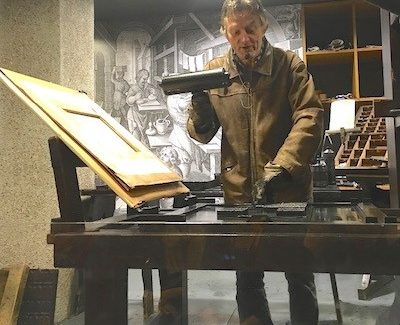Shore Excursion: Gutenberg Museum in Mainz, Germany
His hometown calls him “the Man of the Millennium.” The technology he invented changed the world, our tour guide says.
Can’t say I disagree with those glowing tributes. After all, it might be because of what he perfected that you are reading these words today.
When I visited Mainz, Germany, I signed up for a walking tour that would include the famous Gutenberg Printing Museum. I was not disappointed.
Founded 2,000 years ago by the Romans, Mainz is one of the oldest towns in Germany and it is where Johannes Gutenberg was born, where he introduced his amazing creation, and where he died. With a population of about 200,000, Mainz honors its native son with an excellent museum, including a chance to see a replica of his famous moveable type printing press in action.
“His was one of most import inventions of all time,” tour guide Lothar Schilling said. “For the first time in history, books were available to everybody because of his invention. It was an invention that conquered the world and changed the world for good.”
Man of mystery
For such a famous man, very little is known about the great inventor. “He was born here about 1400 and died here in 1468,” Schilling said. “But we don’t know if he was married, if he had any children. We don’t even know what he looked like.”
Images of Gutenberg in the museum were created 100 years after his death, Schilling added. “It’s the same portrait used for other men of that time as well so that wasn’t what he really looked like.”
In fact, his actual last name name wasn’t Gutenberg. “His name was Johannes Gensfleisch and he lived in Gutenberg Court (Gutenberg was his mother’s maiden name),” Schilling said. “People would identify him that way back then – he was Johannes of Gutenberg Court and eventually just Johannes Gutenberg.”
In Gutenberg’s day, books were copied by hand. Those time-intensive handwritten books were very expensive and only the wealthy had access to them. Of course, back then, most people couldn’t read or write anyway.
“When Johannes Gutenberg invented moveable type printing, it opened up the world of books and reading to everyone,” Schilling said. His revolutionary printing press has been widely considered the most important invention of the modern era because it profoundly impacted the transmission of knowledge.
Invented around 1439, Gutenberg’s movable type printing press allowed manuscripts to be mass-produced at relatively affordable costs. His 42-line Gutenberg Bible, printed around 1455, is considered by many to be the first “modern” printed book.
Seeing famous Gutenberg Bible
Amazingly, we got to spend time in a well-guarded room where the Gutenberg Bibles are on display. Understandably, photos aren’t permitted in that room or anywhere in the museum except in the last exhibit we visited where our guide was allowed to actually print a page for us on a replica Gutenberg printing press to show us how the machine worked.
As for those Bibles, there are only 49 copies left in the world, Schilling said. They are called the 42-line Gutenberg Bible because each page has 42 lines of text.
“We didn’t have a Gutenberg Bible here until 1978,” Schilling said. “It cost $1.8 million and was the first complete Gutenberg Bible returning home. I could rave on for hours about the Gutenberg Bible.”
Called the Shuckburgh Bible, the ornate book in front of us was printed in black and white, then color was later added by an artist. “No two Gutenberg Bibles are the same because no two were done by the same artist,” Schilling said. “Someone would buy a Gutenberg Bible, then pay an artist to add the color and designs.”
Then he pointed out an interesting mistake – the color letter for a large Q has its tail on the wrong side in the Bible. “The artist who did this color couldn’t read so he didn’t know which side the tail should go,” Schilling said.
Gutenberg seemed plagued by politics and business failures during his life and didn’t gather riches despite his world-changing invention. Gutenberg initially borrowed money to finance buying equipment. Then his lender foreclosed and took Gutenberg’s equipment. Hard to be a printer without equipment and supplies.
When Gutenberg was getting back on his feet, a religious/political war erupted in Mainz. “The whole population including Gutenberg was driven out of town,” Schilling said. When people returned, they struggled to pick up their lives again.
“Gutenberg didn’t die exactly poor but he had lost almost everything that was his,” Schilling said. When he died in 1468, Gutenberg was buried in the Franciscan church in Mainz. The church and cemetery were later destroyed and Gutenberg’s grave is now lost.
Gutenberg honored years after death
“When he died, Gutenberg’s amazing contributions were largely unknown,” Schilling said. “He was re-discovered centuries later and people realized how important he was to all of us.”
The excellent Gutenberg Museum was created in 2000 by Gutenberg’s hometown to honor its native son. Along with the Bibles, the museum showcases printing presses spanning a period of several centuries. There are also exhibits on the history of paper and writing, bookplates, graphic arts and posters and many books, magazines, and newspapers.
Before our tour ended, we had 15 minutes in a special exhibit room to watch Schilling operate a replica Gutenberg printing press. It was interesting to see the whole labor-intensive process and see many of us taking photos and videos on our cameras and cell phones.
Technology certainly has evolved over the years. I gave thanks to Gutenberg before leaving the museum. Can’t imagine life without books.
Story and photo by Jackie Sheckler Finch















View Recent Comments